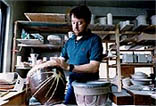|
|
 |
 lutes
can be made from a wide variety of materials. For a long time, the
preferred material in Europe was wood, but ivory, porcelain and even glass
flutes appeared, especially during the baroque period. The modern flute tends
to be made of silver, gold, platinum or plastic. Bamboo plays an important
role in Oriental cultures. In addition to wooden flutes, bone, ceramic and
copper flutes are found in various parts of the
world. lutes
can be made from a wide variety of materials. For a long time, the
preferred material in Europe was wood, but ivory, porcelain and even glass
flutes appeared, especially during the baroque period. The modern flute tends
to be made of silver, gold, platinum or plastic. Bamboo plays an important
role in Oriental cultures. In addition to wooden flutes, bone, ceramic and
copper flutes are found in various parts of the
world.
| |

 Flute
Flute
By
Tony Bloom
Canmore, Alberta
Circa 1985
Porcelain
32.5 cm
Inscribed with the artist's
signature and seal
Gift of the Massey Foundation
|
Earth is a symbol of fertility, wealth and generosity. In many cultures,
ceramic instruments express the desire to unite earth and music in order
to supplicate the benevolent spirits and elicit their favour.
Opus 59 - Flute
| |

 Flute
Flute
By Tony Bloom
Canmore, Alberta
1977
Stoneware
37.8
Inscribed with the artist's
signature and seal
Gift of the Massey Foundation
|
The ceramic flutes and drums presented here are often associated with various
musical traditions. The breath that produces sound in the wind instrument
is a symbol of life, while the beating of the drum symbolizes the human heart.
The union of these two instruments has given rise to a French proverb:
"What comes from the flute goes back to the drum."
Tony Bloom


Instrument making comes naturally to ceramist and musician Tony Bloom. Spurred
by a desire to build a flute for his musician brother, he began experimenting
with pottery and instrument making in Canmore. A few months after taking
courses at the Banff School of Fine Arts, he became a professional artist
and potter. Also a drummer, he has fashioned several darabukkas. Tony Bloom has produced bas-reliefs and sculptures in addition to
musical instruments. |






